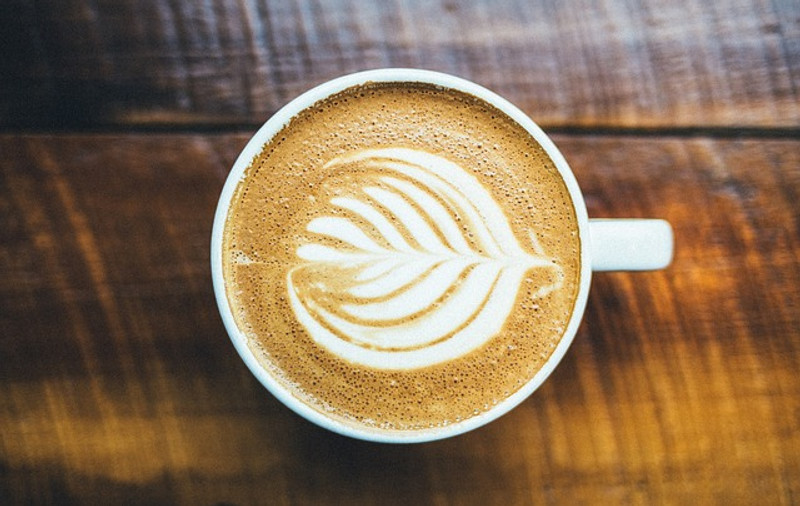
Coffee for the Planet: How Your Coffee Affects Life on Earth
Published by Anne Altor on Aug 3rd 2018
How Your Coffee Affects Life on Earth
How do you choose a good cup of coffee? Not just tasty good, but good for the planet? I used to think that organic Arabica beans were shade-grown and ecosystem friendly. I now know it's not so simple. It's clear though that our coffee choices have a direct impact on the planet! Here's a brief primer on coffee and how our choices can either contribute to deforestation or support habitat creation and preservation:
☕️ Coffee grows in tropical and subtropical climates from sea level up to about 6300 feet. The two major types of coffee are Robusta (Coffea canephora) and Arabica (Coffea arabica). Robusta plants have greater yields per hectare, grow at lower elevations, and require hotter temperatures and more moisture compared to Arabica plants. Robusta beans contain almost twice as much caffeine and a lower lipid and sugar content than Arabica beans. These chemical differences lead to strong differences in taste. Robusta tends to be bitter, harsh and unflavorful and is often used for instant or "cheaper" coffee. Arabica has a wide diversity of flavors, is sweeter and milder than Robusta, and is generally considered to be higher quality.
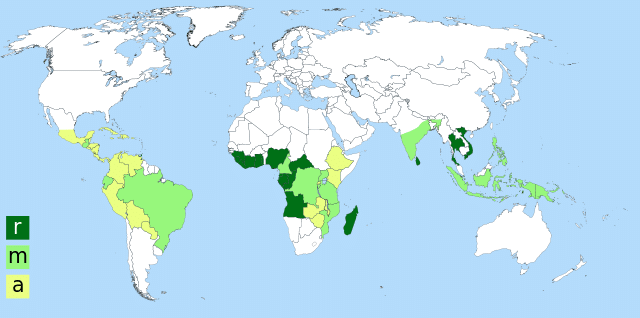
Map of coffee-growing regions. Dark green areas show where Robusta is grown; yellow indicates areas where Arabica is grown, and areas shaded light green grow both varieties. Creative Commons.
Coffee tradition
Coffee has traditionally been grown in shade, under a canopy of native forest trees (Philpott et al., 2008).
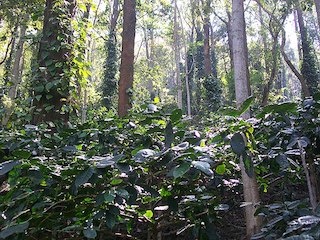
Coffee plantation in Araku Valley, India. Photo by Pinakpani, Creative Commons.
☕️ Because extensive tropical deforestation has occurred, shade coffee farms provide critical habitat for pollinators and resident and migratory birds. They also provide soil and water conservation and carbon storage benefits that were once provided by wild forests (Jha et al. 2014).
☕️ Under pressure to increase productivity, many shade farms have been deforested and converted to full-sun monocultures (Jha et al. 2014). This intensification of coffee crops for short-term increases in yield has drastic consequences:
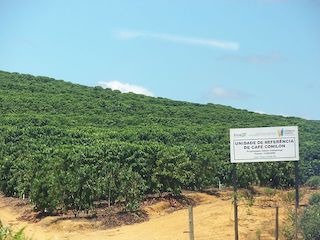
Robusta coffee plantation, Timbuí, Brazil, by Denis Rizzoli
♦️ Loss of some of the last remaining habitat for birds and other species, along with ecosystem functions that all life depends on (Bertrand et al. 2011).
♦️ Full-sun coffee plantations require more chemical fertilizers and pesticides. Monocultures don't support species webs that keep diseases and pests under control. In shade coffee farms, birds eat coffee pests (Wenny et al. 2011), and shade trees "fix" nitrogen, which provides natural fertilizer.
What can an Earth-loving coffee drinker do?
☕️ Our choices in coffee have a DIRECT and POWERFUL effect on the planet. Fortunately, there are options that directly support shade-grown, organic, ecosystem and community-supporting coffee farms. One excellent option is to buy Certified Bird-Friendly coffee!
☕️ BIRD-FRIENDLY COFFEE CERTIFICATION was developed by the Smithsonian Migratory Bird Center. The Bird-Friendly certification ensures that coffee was organically produced in a forested ecosystem. Farmers get better prices for growing certified Bird-Friendly coffee, and their farms support diverse income sources as well as habitat.

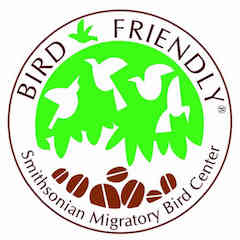
Where can you find Bird-Friendly coffee?
☕️ Some roasters offer bird-friendly coffee, but if you can't find it locally, you can buy it on line. The prices are similar to prices for organic or Fair-Trade coffee.
Limitations of Arabica, Organic, and Fair-Trade
☕️ Arabica plants are adapted to grow in shade. However, arabica hybrids have been developed to grow in full sun. There is a trend to convert shade farms to full sun, so arabica beans can now be grown in unforested plantations. Plants grown in full sun are more susceptible to disease (Toniutti et al. 2017) and are likely to be treated with chemicals unless they're certified organic.
☕️ Organic coffee is more planet-friendly than non-organic, but organic coffee can be grown in full sun. Therefore, organic coffee may still contribute to deforestation.
☕️ Fair-Trade-certified coffee is not necessarily organic or shade grown. There are contrasting views on how well Fair-Trade works for growers and the environment. Some critiques suggest that the way Fair Trade is implemented for coffee is a form of greenwashing that fools ethical consumers while increasing profits for large corporations.
What about Rainforest Alliance Certification?
☕️ It sounds ethical and sustainable, but is Rainforest Alliance Certification as good as it sounds? Unfortunately, the shade requirements for Rainforest Alliance Certified coffee were weakened in the most recent standards. The current Rainforest Alliance Sustainable Agriculture Standard for coffee requires only 20% shade, and that shaded area can consist of "Off-site compensation areas located outside of the farm." In addition, coffee only needs to contain 30% Rainforest Alliance Certified beans in order to carry the label. 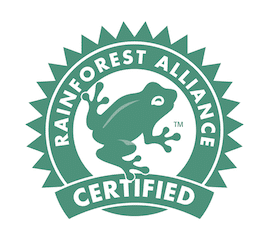 A disclaimer must be placed below the logo stating the percentage of certified beans, but consumers need to know to read the fine print. Coffee with the Rainforest Alliance seal can contain up to 70% non-certified coffee.
A disclaimer must be placed below the logo stating the percentage of certified beans, but consumers need to know to read the fine print. Coffee with the Rainforest Alliance seal can contain up to 70% non-certified coffee.
☕️ Despite these limitations, Rainforest Alliance Certified coffee is a better choice than coffee without any certifications.
Cheap coffee has high costs
We might not see it today, as we sip our coffee in comfort. But the communities poisoned by pesticides and deprived of forests pay the price for our cheap coffee. Birds arrive at their tropical destinations after a grueling migration and find that their trees and food sources are gone. Our choice in coffee beans has a direct impact on tropical ecosystems and communities, and thus on the whole planet. We are all impacted by climate change and biodiversity loss.
Takeaways
☕️ Coffee is one product where our choices can have a strong positive or negative impact! We order our coffee from Birds and Beans. The coffee is DELICIOUS and it makes a great gift. Gifting Bird-Friendly coffee also helps spread the word about a simple and tasty way to help the planet. Bird-Friendly coffee is comparable in price to many other coffee choices.
☕️ Some small growers might not have Bird-Friendly certifications, but could still be farming with practices that encourage healthy forests and biodiversity. Check with your local roaster about their suppliers. Some local roasters have personal connections with the communities that provide their coffee beans. Learn about how they source, it could lead to great conversations.
☕️ Here's a short video about Bird-Friendly coffee:
